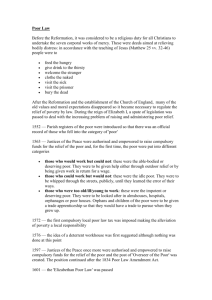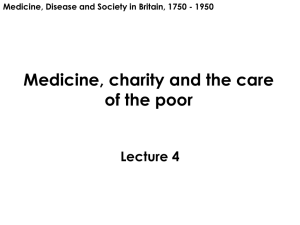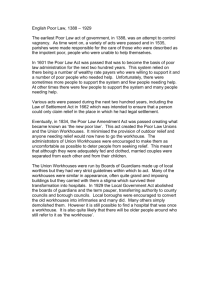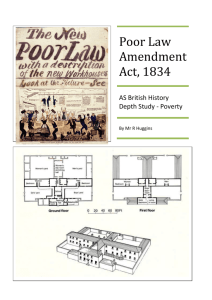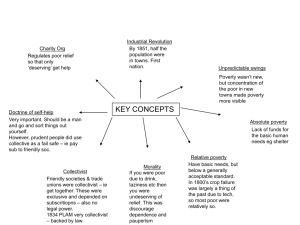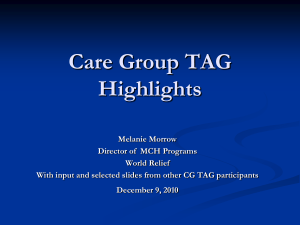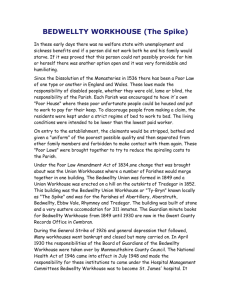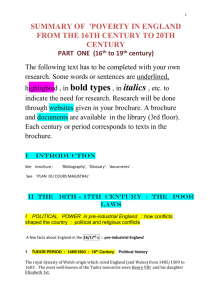File - Beechen Cliff School Humanities Faculty
advertisement
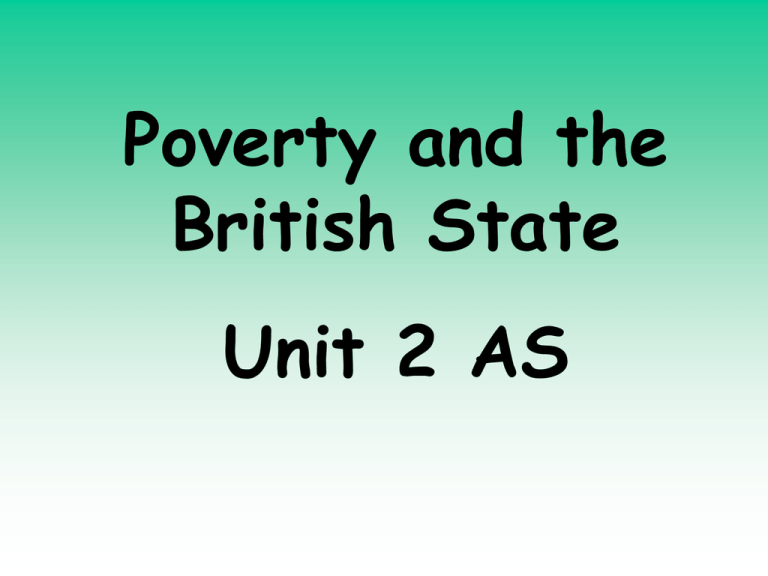
Poverty and the British State Unit 2 AS WHAT WILL I STUDY? The course is divided into sections: • The Old Poor Law: How did it operate? What were its strengths and weaknesses? • Why did people call for change?: Population growth, Industrial Revolution and urbanisation, potential violence, Corruption, Contemporary theorists, The rising cost of poor relief, Harvest failures, other alternatives. • The Royal Commission 1832: The Government body set up to investigate the problems of the old system in preparation for change. Strengths and weaknesses of this Commission. WHAT WILL I STUDY? • The Poor Law Amendment Act 1834: What were the key features of the Act? How far was it reliant on the Royal Commission? What were the key changes? • The Poor Law Commission: How did the new Poor Law operate? Who was in charge of implementing it? • The Workhouse System: What was the principal of less eligibility? How was the new poor law supposed to operate? • Successes and weaknesses of the New Poor Law: Implementation N v S, Support and opposition, Did it achieve its aims or did outdoor relief still operate? Changes to the PLAA 1834-70. The Examination: • It is primarily a source based exam. • You will have 5-6 sources some contemporary and some by Historians. • You will have to answer 2 questions: 1 20 marks (Use 3 sources and explain) and 1 40 marks (Use 2 sources and analyse) (Choice 1 out of 2). • The first exam will be in January and it is 1hour 20 min long. KEY QUESTIONS : • How do we define the Poor? Absolute Poverty? Relative Poverty? Deserving Poor? Undeserving Poor? • How should we provide relief for the poor? Welfare State? Centralised relief? Charity? Outdoor or Indoor Relief? Money/Food/clothing? Punish them? These questions have been asked time and again over hundreds of years! WHAT WAS THE OLD POOR LAW? DID IT NEED TO BE CHANGED? The ‘Old Poor Law’ wasn’t one Law, it was a collection of laws passed by Parliament that dealt with Poor Relief between the 16th Century and the end of the 18th Century. It was an attempt to help the poor through the local Parishes and there had been no new thinking on how the poor should be treated since the Elizabethan Poor Law of 1601. KEY FEATURES: • The sick, old, infirm and mentally ill (impotent poor) were to be looked after in poor houses or almshouses. • Pauper children were apprenticed to a trade. • Able-bodied poor or ‘idle vagabonds’ who needed relief were sent to work in a workhouse while they continued to live at home. • Beggars and Vagrants who refused to work were sent to a ‘House of Correction’ • Each Parish were responsible for their own poor. The local overseer levied a ‘poor rate’ to pay for the relief. Therefore the ideas of ‘settlement’ became important. CHANGES IN THE OLD POOR LAW: 1. The Workhouse Act of 1722-3 • This aimed to make the poor relief self-supporting by using the profits from paupers work to be ploughed back into poor relief. It also allowed Parishes to apply the ‘Workhouse Test’. By 1776 there were 2000 workhouses offering 90,000 places to paupers. It gradually became a place of work AND a place of deterrent. 2. The Gilbert’s Act of 1782 • It allowed parishes to combine in unions to spread the cost of maintaining a poorhouse. By 1832 over 900 parishes had combined into 67 Unions. Paid officers (relieving officer) administered relief. Parishes continued to use ‘Out-door Relief’. 3. The Speenhamland System 1795 • Introduced in 1795 in Speenhamland, Berkshire. The Parish paid a subsidy to paupers that was calculated on a sliding scale according to the price of bread and the size of a pauper’s family. Mainly adopted in the South and not the North. 4. The Labour Rate • Overseers levied a parish rate to cover the cost of relief. They set a ‘Parish Wage Rate’. Ratepayers could then choose to employ labourers and pay them the set parish wage, or they paid the poor rate. If the wages were less than the rate, they would pay the difference to the Parish. 5. The Roundsman System • Able-bodied pauper labourers were employed by the Parish. Rate-payers paid part of their wages and the parish paid the rest. WHY DID MANY PEOPLE BELIEVE CHANGE WAS NEEDED? 1. INDUSTRIALISATION, URBANISATION AND POVERTY: • By the beginning of the 19th Century society had changed. A Massive population growth alongside a volatile labour market had led to mechanisation and industrialisation. This ultimately meant new urban environments developed that were not built to cope with such an influx of people. This led to: an increase in the number of poor; an increase in economic recessions, vulnerability of larger numbers of the population to poverty and a concentration of poor people in the towns and Cities (they became more visible). 2. CONTEMPORARY WRITERS • Some like William Cobbett wanted to keep the old system and even suggested increasing poor rates. Others like Robert Owen and Thomas Paine wanted to modify the existing system. However, others wanted to change the system altogether and their opinions were more readily listened to by the Government. These writers were: Thomas Malthus, David Ricardo, Jeremy Bentham and Edwin Chadwick. They believed that the old poor law encouraged laziness and vice and ultimately was the CAUSE of poverty. 3. RISING COST OF POOR RELIEF • The rising cost of poor relief was probably the most important reason why the Government changed the old poor law. In 1784 the cost was £2 million in 1817 it cost £7.9 million and by 1931 it was £7 million. Costs had increased because of the Napoleonic Wars and a series of poor harvests in the 1820s. This caused support for Malthusian views and that the poor should be deterred from claiming relief. WHY DID MANY PEOPLE BELIEVE CHANGE WAS NEEDED? 4. CORRUPTION OF LOCAL POOR LAW ADMINISTRATORS • Under the old system there were alleged ‘vested interests’. For example contracts for supplying food was given to local tradesmen rather than being put out to local tender. In 1819 the Government allowed Parishes to organise ‘Select Vestries’ committees that would specialise in Poor Law Administration. However, corruption continued. E.g. The Morpeth Select Vestry had a vested interest in the sale of beer and it was alleged that most relief payments ended up being spent in the local ale house. So corruption plus added poor rates led to unhappy ratepayers. 5. ALTERNATIVE SOLUTIONS • In some places local overseers or select Vestries had tried to solve the increasing rate rises but using different systems. In Nottingham George Nicholls and the Rev. Robert Lowe tried to reduce the rising costs by eliminating the allowance system and imposing harsh discipline in the Workhouse. As a result the Workhouse became an object of fear and poor law expenditure Ws reduced from £1884 to £786 between 1822 and 1824. The Government looked favourably on these ‘alternative solutions’ for obvious reasons. 6. FEAR OF REVOLUTION • The final cause of change was the fear of revolution in the countryside. Poor harvests in 1829 and 1830; Poor Law spending per head had decreased in the 1820s and the introduction of new machinery had led to violence like the Swing Riots. Machines and the Workhouse were attacked across the country. The rioters were crushed and harsh penalties meted out but the Government demanded a harsher punishment towards the poor.
